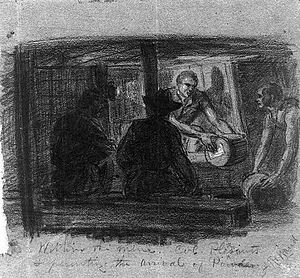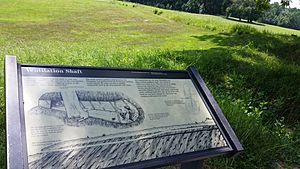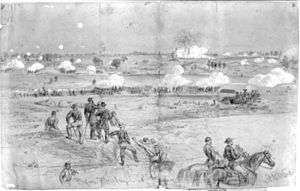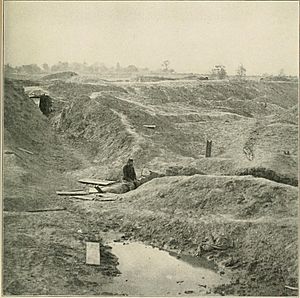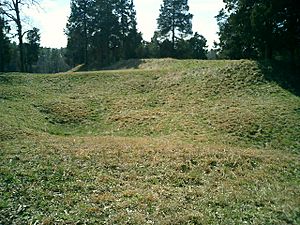Battle of the Crater facts for kids
Quick facts for kids Battle of the Crater |
|||||||
|---|---|---|---|---|---|---|---|
| Part of the American Civil War | |||||||
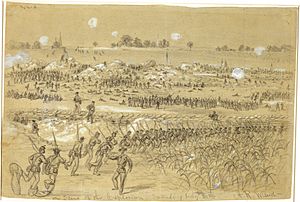 Scene of the explosion July 30th 1864 Alfred R. Waud, artist |
|||||||
|
|||||||
| Belligerents | |||||||
| Commanders and leaders | |||||||
| Ambrose E. Burnside James H. Ledlie |
Robert E. Lee William Mahone |
||||||
| Units involved | |||||||
| IX Corps | Elements of the Army of Northern Virginia | ||||||
| Strength | |||||||
| 8,500 | 6,100 | ||||||
| Casualties and losses | |||||||
| 3,798 total 504 killed 1,881 wounded 1,413 missing or captured |
1,491 361 killed 727 wounded 403 missing or captured |
||||||
The Battle of the Crater was a major event during the American Civil War. It was part of the long siege of Petersburg in Virginia. This battle happened on July 30, 1864. It involved the Confederate Army of Northern Virginia, led by Robert E. Lee. They fought against the Union Army of the Potomac, led by George G. Meade. Ulysses S. Grant, the Union's top general, was also supervising.
Weeks before the battle, Union forces dug a long tunnel. They filled it with explosives under the Confederate defenses. On July 30, they blew up the tunnel. This created a huge hole, or "crater," in the Confederate lines. However, the Union attack after the explosion went very wrong. Many Union soldiers, including United States Colored Troops, rushed into the crater. They became confused and stuck inside. General Grant later called it "the saddest affair I have witnessed in this war."
The Confederates quickly regrouped. General William Mahone led several counterattacks. They managed to close the gap in their defenses. The Union forces were pushed back with heavy losses. This battle was a missed chance for the Union to end the siege of Petersburg. Instead, the fighting continued for another eight months.
After the battle, Union General Ambrose Burnside was removed from command. He never led troops again. Other generals, like James H. Ledlie and Edward Ferrero, were also criticized. A review found that Ledlie had not provided proper leadership during the battle. He was later dismissed from the Army.
Contents
Why the Battle Happened
During the Civil War, Petersburg, Virginia, was a very important city. It was a major hub for railroads coming from the south. These railroads carried most of the supplies for General Lee's army and the Confederate capital, Richmond, Virginia. The Union army saw Petersburg as the "back door" to Richmond. Taking Petersburg was key to winning the war.
The fighting around Petersburg became a siege. This wasn't a typical siege where an army surrounds a city. Instead, it was like trench warfare. Both armies built long lines of forts and trenches. These lines stretched for over 20 miles (32 km).
After trying to capture Petersburg in June, General Grant faced a stalemate. He had learned that attacking Lee's strong defenses head-on was very costly. Then, a Union officer named Henry Pleasants came up with a new idea. He was a mining engineer in his civilian life. Pleasants suggested digging a long tunnel under the Confederate lines. He planned to plant explosives right under one of their forts.
If the plan worked, the explosion would kill defenders and create a large hole. Union troops could then rush through this gap. They would push into the Confederate rear. This might allow them to capture Petersburg. General Burnside, whose reputation had suffered from past defeats, agreed to Pleasants's plan.
Building the Mine
Work on the mine began in late June. Even Grant and Meade didn't think the mine would be very useful. They saw it mostly as a way to keep the soldiers busy. So, Pleasants didn't get much support or materials. His men even had to find their own wood to support the tunnel.
Despite these challenges, the work continued steadily. Soldiers dug out earth by hand. They used improvised sleds made from cracker boxes to remove the dirt. The tunnel's walls and ceiling were supported with wood. This wood came from an old mill and even a torn-down bridge.
The tunnel was built with a slight upward slope. This helped prevent water from collecting inside. An clever air system kept fresh air flowing to the miners. A fire at the base of a vertical shaft created a "chimney effect." This pulled stale air out of the tunnel. Fresh air then flowed in from the entrance through a wooden duct. This system kept the air clean without needing more shafts that the enemy could see. It also helped hide the digging.
By July 17, the main tunnel reached under the Confederate position. Rumors about the mine reached the Confederates. But General Lee didn't believe them at first. He waited two weeks before trying to dig counter-tunnels. These efforts were slow and didn't find the Union mine. However, Confederate General John Pegram took the threat seriously. He built new trenches and artillery spots behind his main position as a backup.
The mine was shaped like a "T." The main tunnel was 511 feet (156 m) long. It started in a low area, over 50 feet (15 m) below the Confederate fort. This made it hard to detect. The tunnel was narrow, about 3 feet (1 m) wide and 4.5 feet (1.4 m) high. At its end, a 75 feet (23 m) long tunnel extended sideways.
After a failed Union attack elsewhere, Grant and Meade decided to use the mine. Union soldiers filled the mine with 320 kegs of gunpowder. This was a total of 8,000 pounds (3,600 kg) of explosives. The charges were about 20 feet (6 m) under the Confederate defenses. To direct the explosion upwards, the tunnel behind the explosives was packed with earth.
Planning the Attack
General Burnside had a plan for the assault. He trained a division of United States Colored Troops (USCT) to lead the attack. These soldiers practiced for two weeks. They learned how to move around the crater and push forward. Their goal was to seize key roads and, if possible, Petersburg itself. Burnside's other divisions, made of white troops, would follow to support them.
However, the day before the attack, General Meade changed the plan. He ordered Burnside not to use the black troops in the lead. Meade worried that if the attack failed, many black soldiers would die. This could cause political problems in the North. He also might have doubted their fighting abilities. Burnside argued, but Grant sided with Meade.
Since no white divisions volunteered to lead, Burnside chose one by drawing lots. General James H. Ledlie's division was chosen. But Ledlie did not tell his men what to do. During the battle, he was reported to be far behind the lines. He was later removed from the army for his actions.
The Battle Begins
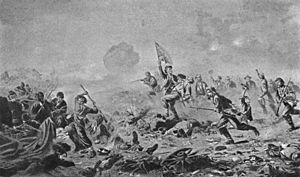
The mine was supposed to explode between 3:30 and 3:45 a.m. on July 30. The fuse was lit, but it was of poor quality. It burned out before reaching the explosives. Two brave volunteers, Lt. Jacob Douty and Sgt. Harry Reese, crawled into the tunnel. They found the problem, fixed the fuse, and relit it.
Finally, at 4:44 a.m., the charges exploded! A massive blast sent earth, men, and guns flying. It created a huge crater, which is still visible today. The crater was 170 feet (52 m) long, 100 to 120 feet (30 to 37 m) wide, and at least 30 feet (9 m) deep. The explosion instantly killed 278 Confederate soldiers.
The Confederates were stunned and didn't fire for about 15 minutes. But Ledlie's untrained Union division was not ready. They waited 10 minutes before moving. They were supposed to have bridges to cross their own trenches quickly, but these were missing. So, they had to climb out of their trenches.
When they reached the crater, they made another mistake. Instead of going around it, as the black troops had been trained, they went down into it. They thought it would be a good place to hide. But the crater was too deep and exposed. It quickly became overcrowded. Meanwhile, Confederate General William Mahone quickly gathered his troops.
In about an hour, Mahone's men surrounded the crater. They began firing rifles and artillery down into it. Mahone later described it as a "turkey shoot," meaning it was easy to hit targets.
The Union plan had failed badly. But Burnside still sent in Ferrero's black troops. They also went into the crater, facing heavy fire. For hours, Mahone's soldiers and artillery caused many casualties among the Union IX Corps. Some Union troops did manage to advance beyond the crater. They fought fiercely in hand-to-hand combat. But Mahone's Confederates launched a strong counterattack. They reclaimed their positions and pushed the Union forces back.
After the Battle
The Union suffered 3,798 casualties. This included 504 killed, 1,881 wounded, and 1,413 missing or captured. Many of these losses were from Ferrero's division of United States Colored Troops. The Confederates had 1,491 casualties. This included 361 killed, 727 wounded, and 403 missing or captured.
After the battle, General Meade brought charges against Burnside. A special investigation criticized Burnside and other generals. Burnside was never given command again. Although Meade was also responsible, he avoided immediate blame. However, a later Congressional committee blamed Meade for changing the attack plan. This didn't help Burnside's ruined reputation. General Mahone, on the other hand, gained fame for his efforts in this victory.
General Grant wrote that it was "the saddest affair I have witnessed in this war." He also said, "Such an opportunity for carrying fortifications I have never seen and do not expect again to have."
Lieutenant Colonel Pleasants, who designed the mine, received praise. He was promoted to brevet brigadier general. His citation specifically mentioned his role in the mine's creation.
Grant later explained why the black troops were not in the lead. He said that if the attack failed, people might say they were sent to die because no one cared about them. He felt it was better to send white troops first to avoid such criticism.
Even though the Confederates won the Battle of the Crater, the overall situation didn't change much. Both armies stayed in their trenches. The long siege of Petersburg continued.
Visiting the Historic Site
The area where the Battle of the Crater took place is now part of Petersburg National Battlefield Park. Many people visit this site. The entrance to the mine is opened once a year on the battle's anniversary. You can still see sunken areas where air shafts were and where parts of the tunnel collapsed. The park also includes other important sites from the Union lines around Petersburg.
In Popular Culture
- The Battle of the Crater is shown in the beginning of the 2003 film Cold Mountain. Jude Law plays a Confederate soldier in the movie. However, the film incorrectly shows the explosion happening in broad daylight. In reality, it happened in the dark at 4:44 a.m.
See also
 In Spanish: Batalla del Cráter para niños
In Spanish: Batalla del Cráter para niños


